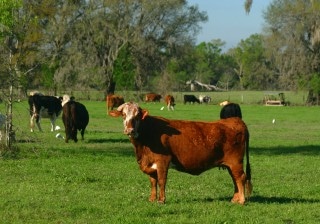Jun 23 2016
University of Florida Institute of Food and Agricultural Sciences researchers hope to reduce possible pollutants emanating from soils in Florida cattle ranches by using a $710,000 federal grant to study soil microbes.
 University of Florida Institute of Food and Agricultural Sciences researchers hope to reduce possible pollutants emanating from soils in Florida cattle ranches by using a $710,000 federal grant to study soil microbes.(Credit- Tyler Jones, UF/IFAS photography)
University of Florida Institute of Food and Agricultural Sciences researchers hope to reduce possible pollutants emanating from soils in Florida cattle ranches by using a $710,000 federal grant to study soil microbes.(Credit- Tyler Jones, UF/IFAS photography)
In the new study, UF/IFAS researchers will use lab and field studies to investigate how pasture management and factors such as temperature and rainfall affect soil microbes. They’ll also look for genetic markers to get a glimpse into microbial identity. Genetic markers are genes or short sequences of DNA scientists use to find other genes on a genetic map.
“The goal is to put together a model that can predict the release of greenhouse gases like carbon dioxide and nitrous oxide from soils under a climate that is expected to be warmer and experience more extreme dry and wet periods across the Southeast,” said Stefan Gerber, a UF/IFAS assistant professor in soil and water sciences and one of the investigators on the new study.
The scientific team includes Gerber and fellow UF/IFAS soil and water sciences faculty members Patrick Inglett, Kanika Inglett and Maria Silveira, collaborating with Ryan Penton, an Arizona State University-based microbiologist.
Soils naturally absorb and retain carbon dioxide. They also produce nitrous oxide from soil nitrogen. Carbon in the soil is primarily in the form of organic matter. Carbon dioxide is produced when soil microbes eat plant litter and soil organic matter, Gerber said.
“This is essentially the same process as when we humans consume food,” Gerber said. “We, and microbes, consume organic materials and metabolize, or burn, them and give off wastes.”
Gerber, Inglett and their colleagues hope that their results can help guide ranchers to manage their land in such a way that they reduce greenhouse gas emissions and maybe even receive credit for storing carbon. Ranch management can include factors such as more or fewer cows in a given area, how much fertilizer is applied to the ground, whether the land manager chooses specific plants to grow and whether the manager decides to burn vegetation periodically, Inglett said.
The three-year study, which begins in August, is funded by the U.S. Department of Agriculture-Agriculture and Food Research Initiative.